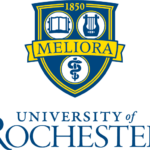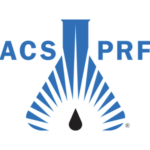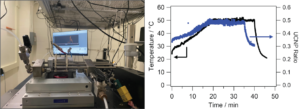Optical Super-Resolution Nanothermometry
 Super-resolution techniques revolutionized biological imaging by revealing cellular structures in unprecedented detail, as recognized by the 2014 Nobel Prize in Chemistry. Such methods combine nanoscale spatial resolution and far-field optics to achieve non-invasive, high-resolution optical imaging. Applying super-resolution concepts to thermometry would likewise yield immense benefits, from unraveling device thermal failure mechanisms to validating predicted deviations from classical heat transfer laws at the nanoscale. To realize this outcome, we are developing stimulated emission depletion (STED) super-resolution nanothermometry techniques based on upconverting nanoparticles (UCNPs) and related lanthanide-containing materials. Using our custom-built STED system, we perform temperature-dependent STED imaging and spectroscopy measurements, develop novel detection schemes, and ultimately apply these new optical super-resolution nanothermometry techniques to operating devices.
Super-resolution techniques revolutionized biological imaging by revealing cellular structures in unprecedented detail, as recognized by the 2014 Nobel Prize in Chemistry. Such methods combine nanoscale spatial resolution and far-field optics to achieve non-invasive, high-resolution optical imaging. Applying super-resolution concepts to thermometry would likewise yield immense benefits, from unraveling device thermal failure mechanisms to validating predicted deviations from classical heat transfer laws at the nanoscale. To realize this outcome, we are developing stimulated emission depletion (STED) super-resolution nanothermometry techniques based on upconverting nanoparticles (UCNPs) and related lanthanide-containing materials. Using our custom-built STED system, we perform temperature-dependent STED imaging and spectroscopy measurements, develop novel detection schemes, and ultimately apply these new optical super-resolution nanothermometry techniques to operating devices.
Publications: Ye et al., Science Advances (2024)
Funding: Furth Fund Award; NSF CAREER Award


Thermal Contributions to Plasmonic Photocatalysis
 Many experimental demonstrations have shown that chemical reaction rates can be strongly enhanced when reactions are performed on the surfaces of plasmonic nanostructures. Plasmonic photocatalysis is appealing because it could potentially reduce the energy input required for important industrial reactions and allow the use of sunlight, rather than fossil fuel-derived energy, to catalyze these reactions. However, the detailed mechanisms behind the observed plasmonic enhancement remain strongly contested, particularly in terms of the relative contributions of hot electron effects vs. surface heating. We have developed a dual-mode operando thermometry and reaction monitoring technique, which allows for simultaneous yet separate measurements of the plasmonic surface temperature via upconverting nanoparticle (UCNP)-based luminescence thermometry and the reaction progress via Raman spectroscopy. We have used this method to study the photocatalyzed dimerization of 4-nitrothiophenol to 4,4’-dimercaptoazobenzene, and we are now further expanding the capabilities of our approach and applying it to investigate other reactions.
Many experimental demonstrations have shown that chemical reaction rates can be strongly enhanced when reactions are performed on the surfaces of plasmonic nanostructures. Plasmonic photocatalysis is appealing because it could potentially reduce the energy input required for important industrial reactions and allow the use of sunlight, rather than fossil fuel-derived energy, to catalyze these reactions. However, the detailed mechanisms behind the observed plasmonic enhancement remain strongly contested, particularly in terms of the relative contributions of hot electron effects vs. surface heating. We have developed a dual-mode operando thermometry and reaction monitoring technique, which allows for simultaneous yet separate measurements of the plasmonic surface temperature via upconverting nanoparticle (UCNP)-based luminescence thermometry and the reaction progress via Raman spectroscopy. We have used this method to study the photocatalyzed dimerization of 4-nitrothiophenol to 4,4’-dimercaptoazobenzene, and we are now further expanding the capabilities of our approach and applying it to investigate other reactions.
Publications: Ye et al., Adv. Opt. Mater. (2023)
Funding: ACS PRF Doctoral New Investigator Award; NSF CHE-2304570


Controlling Heat Flow for Carbon Capture and Conversion
 In collaboration with Marc Porosoff in the Department of Chemical Engineering, we are using upconverting nanoparticle (UCNP)-based luminescence thermometry to improve the effectiveness of adsorptive carbon capture and subsequent conversion to useful products. After first characterizing the temperature profiles of solid-state adsorbents during the adsorption process, we aim to then tune the adsorbent properties and the resulting temperature profile in order to more efficiently use the heat generated by exothermic reactions to convert CO2 into value-added products.
In collaboration with Marc Porosoff in the Department of Chemical Engineering, we are using upconverting nanoparticle (UCNP)-based luminescence thermometry to improve the effectiveness of adsorptive carbon capture and subsequent conversion to useful products. After first characterizing the temperature profiles of solid-state adsorbents during the adsorption process, we aim to then tune the adsorbent properties and the resulting temperature profile in order to more efficiently use the heat generated by exothermic reactions to convert CO2 into value-added products.
Funding: Carbontech Development Initiative

Single-Nanodiamond Luminescence Thermometry
 Nitrogen vacancy (NV) centers are bright, photostable luminescent defects found in nanocrystalline and bulk diamond that have applications in quantum information processing, magnetometry, bioimaging, and thermometry. While the most common NV center thermometry method is based on optically detected magnetic resonance (ODMR), we instead focus on all-optical NV center thermometry techniques that avoid the need for a microwave antenna, simplifying the required instrumentation and avoiding potential parasitic microwave heating. We have shown that the excited state lifetime lifetimes of NV centers in individual nanodiamonds enable single-point temperature measurements with sub-100 nm spatial resolution and sub-100 nm temporal resolution, while atomic force microscope (AFM)-based nanomanipulation allows us to place individual nanodiamonds at specific locations on a sample surface.
Nitrogen vacancy (NV) centers are bright, photostable luminescent defects found in nanocrystalline and bulk diamond that have applications in quantum information processing, magnetometry, bioimaging, and thermometry. While the most common NV center thermometry method is based on optically detected magnetic resonance (ODMR), we instead focus on all-optical NV center thermometry techniques that avoid the need for a microwave antenna, simplifying the required instrumentation and avoiding potential parasitic microwave heating. We have shown that the excited state lifetime lifetimes of NV centers in individual nanodiamonds enable single-point temperature measurements with sub-100 nm spatial resolution and sub-100 nm temporal resolution, while atomic force microscope (AFM)-based nanomanipulation allows us to place individual nanodiamonds at specific locations on a sample surface.
In collaboration with Nick Vamivakas in the Institute of Optics, we are also using NV centers in optically levitated nanodiamonds to probe heat transfer in rarefied gases. Traditionally, studying heat transfer in gases using laser-heated nanoparticles is challenging because in essentially all realistic scenarios, most heat is dissipated through the substrate or support on which the nanoparticle sits rather than into the surrounding gas. Optical levitation offers a unique solution to this challenge by eliminating the need for a substrate or support. Using individual optically levitated nanodiamonds, we have shown that at low pressures where the mean free path of the surrounding Ar gas greatly exceeds the nanodiamond radius, the nanodiamond experiences a temperature rise far larger than the classical Fourier’s law prediction. These results establish levitated optomechanics as a novel experimental platform for investigating sub-continuum heat transfer.
Publications: Bommidi and Pickel, Appl. Phys. Lett. (2021); Luntz-Martin et al., Opt. Express (2023)
Funding: University Research Award
